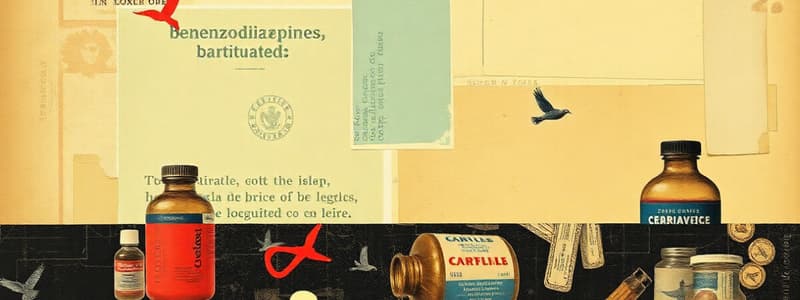Podcast
Questions and Answers
What was the primary purpose for synthesizing benzodiazepines in the 1950s?
What was the primary purpose for synthesizing benzodiazepines in the 1950s?
- To replace barbiturates in illicit use
- To create a new class of anesthetics
- To treat chronic headaches
- To find a safer anxiolytic and sedative-hypnotic (correct)
Which barbiturate was first synthesized and marketed in 1903?
Which barbiturate was first synthesized and marketed in 1903?
- Barbital (correct)
- Amobarbital
- Thiopental
- Phenobarbital
Which type of benzodiazepine is more likely to be prescribed today?
Which type of benzodiazepine is more likely to be prescribed today?
- Barbiturate alternatives
- Benzodiazepines for illicit recreational use
- Short-acting benzodiazepines without active metabolites (correct)
- Long-acting benzodiazepines with active metabolites
What condition was phenobarbital primarily marketed to treat?
What condition was phenobarbital primarily marketed to treat?
During what time period did the prescription rate of benzodiazepines peak?
During what time period did the prescription rate of benzodiazepines peak?
What is a common misconception about the use of benzodiazepines (BDZs)?
What is a common misconception about the use of benzodiazepines (BDZs)?
Which of the following benzodiazepines has active metabolites?
Which of the following benzodiazepines has active metabolites?
What is a best practice for prescribing benzodiazepines (BDZs)?
What is a best practice for prescribing benzodiazepines (BDZs)?
What describes the main route of administration for barbiturates and benzodiazepines?
What describes the main route of administration for barbiturates and benzodiazepines?
What is a common reason for the illicit use of benzodiazepines (BDZs)?
What is a common reason for the illicit use of benzodiazepines (BDZs)?
Flashcards
Barbiturates' historical use
Barbiturates' historical use
Historically used as sedatives, anesthetics, and to treat seizures and headaches.
Benzodiazepines' early development
Benzodiazepines' early development
Developed in the 1950s as a safer alternative to older anxiolytics.
Benzodiazepine prescription change
Benzodiazepine prescription change
Prescription rates for benzodiazepines as anxiolytics have decreased, but prescriptions for short-acting BDZs as sedative-hypnotics have remained high.
Barbiturates' effect on the body
Barbiturates' effect on the body
Signup and view all the flashcards
Benzodiazepines' effect on the body
Benzodiazepines' effect on the body
Signup and view all the flashcards
Benzodiazepines (BDZs)
Benzodiazepines (BDZs)
Signup and view all the flashcards
Illicit use of BDZs
Illicit use of BDZs
Signup and view all the flashcards
Barbiturates (BBTs)
Barbiturates (BBTs)
Signup and view all the flashcards
Controlled substances
Controlled substances
Signup and view all the flashcards
Absorption comparison (BDZs and BBTs)
Absorption comparison (BDZs and BBTs)
Signup and view all the flashcards
Study Notes
Psychopharmacology of Addictive Behaviour - Week 11 Notes
- Topic: Action & Effects of Anxiolytics & Sedative-Hypnotics
- Lecture Outline:
- Definition of anxiolytics & sedative-hypnotics
- History of these drugs
- Administration, distribution, and excretion
- Effects on physiology and performance (e.g., barbiturates, benzodiazepines)
- Conditioning, tolerance, and withdrawal
- Harmful effects
- Reflection Questions:
- Key differences between anxiolytics & sedative-hypnotics
- Identifying characteristics of a benzodiazepine or barbiturate used for presurgical analgesia vs. other uses
- Similarities/differences in absorption, distribution, and metabolism of barbiturates, benzodiazepines, and alcohol, including neurobiological actions
- Likely effects of Valium and alcohol on a flight
- Why a doctor might prescribe a benzodiazepine over a barbiturate for sleep
- Potential side effects and precautions
- Different withdrawal symptoms based on duration and type of BDZs used and individual differences
What are Anxiolytics & Sedatives?
- Anxiolytics and sedative-hypnotics reduce anxiety, induce sedation, aid sleep, act as anticonvulsants, and anaesthetics
- Three classes of drugs achieve these effects: benzodiazepines (BDZs), barbiturates (BBTs), and others
- These drugs share similar neural mechanisms
History of Anxiolytics & Sedative-Hypnotics
- Progression: alcohol & opiates → barbiturates → benzodiazepines
History of Barbiturates
- 1864: Adolf von Baeyer synthesizes barbituric acid
- 1882: Barbital synthesized
- 1903: Barbital marketed
- 1912: Phenobarbital marketed
- 1960s: Illicit use as "downers"
- Various barbiturates were marketed for diverse medical conditions (seizures, headaches, anesthetics)
History of Benzodiazepines
- 1950s: Research for a safer anxiolytic/sedative-hypnotic
- 1957: Chlordiazepoxide (Librium) discovered & marketed
- 1963: Diazepam (Valium) discovered & marketed
- 1970s: Peak prescription rate as anxiolytics
- Shift towards shorter-acting BDZs
- Continued high prescription rates as sedative-hypnotics
Neurophysiology of Anxiolytics
- Affect GABAA receptors, which are ionotropic and linked to chloride channels leading to quick responses
- Generally increase GABA's effectiveness
- Barbiturates increase duration of GABA action, causing wider opening of the chloride channel
- Benzodiazepines increase the frequency of chloride channel opening and enhance GABA's affinity to the GABA receptor
Administration & Absorption of BBTs and BDZs
- Often administered orally, but other routes (e.g., intravenous) are possible to affect absorption
- Generally, oral absorption is better for BBTs and BDZs than other routes, due to their biochemical properties
- Biochemical properties as weak acids, with variability in lipid solubility
- pKa and different lipid solubility profiles influence absorption rates from the GIT, with absorption potentially increased by alcohol
- pKa of BBTs is ~8.0, and pKa of BDZs is ~3.5-5.0
Distribution of Anxiolytics
- Lipid solubility influences distribution throughout the body
- Cross the placental barrier and are present in breast milk
- Highly lipid-soluble drugs (BBTs & BDZs) quickly cross the blood-brain barrier (BBB)
- Drugs are released from fat deposits slowly, and metabolized by the liver
Excretion of BDZs
- Two-phase excretion curve
- Phase 1: Rapid drop in blood level due to redistribution in fat deposits
- Phase 2: Metabolism (liver, CYP450 enzyme)
- Half-life ranges from ~2-10 hours (phase 1) and ~27-48 hours (phase 2)
- Older BDZs are almost fully metabolized, and duration of effect is not just dependent on the half-life
- Metabolism may be increased by repeated doses and slowed by alcohol
Excretion of BBTs
- Primarily metabolized by liver enzymes prior to excretion
- Metabolism is increased with repeated administration
- Certain drugs, (e.g., antipsychotics, anesthetics, chronic alcohol use, antihistamines, nicotine) can also ↑ metabolism
Effects on the body (BDZs)
- Mildly reduce respiration (vs. other CNS depressants)
- Mildly lower blood pressure
- Increased appetite and weight gain
- Increase muscle relaxation (CNS effect)
- Anticonvulsant effects (petit mal seizures & infantile spasms)
Effects on Sleep (BDZs)
- Effective for short-term sleep interventions
- Reduce time to fall asleep, and decreases awakenings, increasing total sleep time
- May decrease REM sleep and Stages 3 & 4 sleep; the withdrawal rebound effect
- Tolerance does not develop typically with BDZs
Subjective Effects (BDZs)
- Possible sedation, fatigue or confusion
- Possible euphoria or a "liking" effect
- May not be anxiolytic to individuals with normal anxiety levels
Effects on Performance (BDZs)
- Deficits in vision, simple reaction time, and explicit memory are possible
- Adverse effects can occur at very low doses
- Higher risk/incidence for drug-related impairment in many studies
- Clinically-anxious individuals may have performance benefits
Hangover Effects (BDZs)
- Mood and performance disruptions last for (at least) 12 hours post administration
- Amplifies the effects of alcohol
- Risk of increased collisions in driving
Effects on the body (BBTs)
- Significant reduction in respiration, heart rate, and blood pressure
- Anticonvulsant effects
Effects on Sleep (BBTs)
- Decreased sleep onset latency
- Increased total sleep time
- REM sleep tolerance after 1 week
- Withdrawal rebound effects of up to 40% of sleep time for several weeks
Subjective effects (BBTs)
- Effects are similar to benzodiazepines
Effects on Performance (BBTs)
- Decreased visual acuity, increased estimation of time and lack of steadiness during tasks
- Poorer tracking ability, decreased attention and athletic performance
- Increased risk in driving/collision potential
Hangover Effects (BBTs)
- Simple reaction time deficits days after administration
- Body steadiness decreases after 18 hours, equivalent to a blood alcohol level of .15
- Risk of collisions during driving/operation of heavy machinery increases
Conditioning, Discrimination, Tolerance, & Withdrawal of Anxiolytics & Sedative-Hypnotics
- Conditioning: Learning that associates a stimulus (drug) with a response (effect)
- Discrimination: Ability to distinguish between different types of drugs
- Tolerance: Decreased response to a drug over time with repeated use
- Withdrawal: Negative effects when drug use is stopped after chronic use
Tolerance (BBTs)
- Acute and chronic tolerance can develop
- Tolerance may develop at different rates for different effects (e.g., antiepileptic effects show little tolerance)
Tolerance (BDZs)
- Tolerances are acute, selective & can occur during a single dose
Cross-tolerance
- Barbiturates and benzodiazepines show considerable cross-tolerance with each other, other depressants, and metabolizing enzymes
- Cross-tolerance may also occur between different types of benzodiazepines or barbiturates
Harmful Effects of Barbiturates
- Reproduction: Developmental effects on infants whose mothers use BBTs during pregnancy (e.g., birth defects, cleft lip/palate, CNS/heart/skeletal abnormalities, lower brain weight, delayed development, ↓male sexual behavior, learning disabilities, psychosocial problems)
- Overdose: Highly additive effect with alcohol; respiratory depression, coma, death
Harmful Effects of Benzodiazepines
-
Reproduction: Inconclusive research, but possible association with birth defects, fetal benzodiazepine syndrome, and poor neurological development
-
Overdose: Not as dangerous as overdose of BBTs; may increase CNS depression and result in respiratory depression
-
General: Underlying cause of anxiety or insomnia remains untreated; Disruption of sleep leads to REM sleep deprivation, possible over-sedation (especially in older people), and risk for dependency
BDZ and BBT Self Administration
- Reinforcement properties shown in lab animals & humans; significant for street use and iatrogenic use
- Self-administration may occur in conjunction with other substances
Other Reminders
- Review tutorial schedule, and upcoming exam prep workshops and tutor of the year nominations/student surveys
Studying That Suits You
Use AI to generate personalized quizzes and flashcards to suit your learning preferences.
Related Documents
Description
Test your knowledge on the history of benzodiazepines and barbiturates with this quiz. Dive into the important events from the 1950s to the factors influencing prescription practices over the years. Understand the key medications and their intended purposes.




